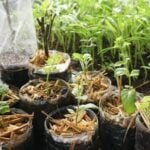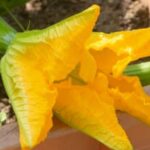Are you looking for the best netting for vegetable gardens? Netting is an essential tool for protecting your valuable plants from pests and other potential threats. In this article, we will explore the importance of using netting in your vegetable garden, different types of netting materials available, and how to choose the best netting for your specific needs.
Netting serves as a protective barrier to keep unwanted visitors like birds, insects, and small animals away from your vegetables. It also helps to create a microclimate by providing shade and reducing wind exposure, which can be beneficial for certain crops. With the right netting in place, you can ensure that your vegetable garden thrives and produces a bountiful harvest.
There are various types of netting materials to choose from, each with its own set of pros and cons. From bird netting to insect mesh, understanding the different options available will help you make an informed decision for your vegetable garden.
We will also discuss how to install netting effectively and provide tips for maintaining it to extend its longevity. Stay tuned as we delve into the world of netting for vegetable gardens and learn how to make the best choice for your gardening needs.
The Importance of Netting for Protecting Vegetable Gardens
Netting for vegetable gardens plays a crucial role in protecting your plants from various pests and environmental factors. From preventing birds from feasting on your ripe tomatoes to shielding delicate seedlings from harsh sunlight, the right netting can make all the difference in the success of your garden.
One of the primary reasons why netting is so important for vegetable gardens is its ability to keep pests at bay. Birds, insects, and small animals can wreak havoc on your carefully tended vegetables, but with the right netting in place, you can effectively deter these unwanted visitors. Additionally, netting can provide shade for sensitive plants during scorching summer days or protect them from strong winds that may damage or break fragile stems.
The best netting for vegetable gardens will also help regulate temperature and humidity levels, providing an optimal growing environment for your plants. By creating a barrier against extreme weather conditions, netting can contribute to healthier and more productive crops. Ultimately, the importance of netting lies in its ability to create a protective shield around your vegetable garden, ensuring that your plants have the best chance of thriving and producing a bountiful harvest.
Different Types of Netting for Vegetable Gardens
When it comes to protecting your vegetable garden from pests and other potential threats, choosing the right type of netting is crucial. There are several different types of netting available on the market, each with its own unique set of features and benefits.
One popular option is bird netting, which is designed to keep birds from feasting on your precious crops. This type of netting is typically made from lightweight and durable materials that allow sunlight and water to reach your plants while keeping birds at bay.
Another common choice is insect netting, which acts as a barrier to prevent insects and other small pests from damaging your vegetables. Insect netting can be particularly effective in preventing infestations of common garden pests such as aphids, caterpillars, and beetles.
Shade netting is another option that can provide multiple benefits for your vegetable garden. This type of netting helps to filter and reduce direct sunlight, providing shade for sensitive crops during hot summer months.
Additionally, shade netting can also protect your plants from harsh weather conditions like hail or strong winds. Ultimately, the insect-netting-is-a-game-chan/” target=”_blank” rel=”follow noopener”>best netting for vegetable gardens will depend on the specific needs of your garden, including the types of pests you’re dealing with and the climatic conditions in your area.
Pros and Cons of Various Netting Materials
When it comes to protecting your vegetable garden, choosing the right netting material is crucial. There are several options available, each with its own set of pros and cons. Understanding the advantages and drawbacks of various netting materials will help you make an informed decision for your garden.
One of the most popular netting materials for vegetable gardens is nylon. Nylon netting is durable, lightweight, and resistant to UV rays, making it a long-lasting option for protecting your plants. However, some gardeners may find that nylon netting can be prone to snagging or tearing, especially if not handled carefully.
Another common choice for vegetable garden netting is polyethylene. Polyethylene netting is known for its strength and resilience, making it an effective barrier against birds and insects. However, some gardeners may find that polyethylene netting can be more challenging to install due to its rigidity.
For those looking for a more environmentally friendly option, there are also biodegradable netting materials available. These nets are designed to break down over time, reducing waste and minimizing environmental impact. However, the biodegradability of these materials can also mean a shorter lifespan compared to traditional synthetic options.
How to Choose the Best Netting for Your Vegetable Garden
When it comes to choosing the best netting for your vegetable garden, there are several factors to consider. The right netting can make a huge difference in protecting your crops from pests and adverse weather conditions, so it’s crucial to select the most suitable option for your specific needs. Here are some key considerations to keep in mind when choosing netting for your vegetable garden.
Types of Pests
One of the first things to consider when choosing netting for your vegetable garden is the types of pests you need protection from. Different netting materials have varying mesh sizes that can prevent certain pests from accessing your plants. For example, if you’re dealing with birds or larger insects, you’ll want a netting with smaller mesh sizes to effectively keep them out.
Weather Conditions
Another important factor to consider is the weather conditions in your area. If you live in a region with strong winds or heavy rainfall, you’ll need a durable and sturdy netting material that can withstand these elements. Look for options that are specifically designed for weather resistance and longevity, such as UV-resistant and tear-resistant netting.
Environmental Impact
It’s also essential to take into account the environmental impact of the netting material you choose. Opt for eco-friendly and non-toxic options that won’t harm beneficial insects or leach harmful chemicals into the soil. Additionally, consider whether the netting material can be easily recycled or repurposed at the end of its lifespan.
By carefully considering these factors, you can make an informed decision on the best netting for your vegetable garden, ensuring maximum protection and long-term sustainability for your crops.
Installing Netting for Maximum Effectiveness
When it comes to protecting your vegetable garden from pests and other environmental threats, installing the right netting is crucial. Here are some steps to ensure maximum effectiveness when installing netting for your vegetable garden:
1. Clear the Area: Before installing the netting, make sure to clear the area of any debris or obstructions that could potentially damage the netting or interfere with its effectiveness. This includes removing any rocks, sticks, or other sharp objects from the ground.
2. Proper Positioning: It’s important to position the netting in such a way that it completely covers and protects the entire vegetable garden. Make sure to leave enough slack in the netting so that it can be securely anchored without causing any damage to your plants.
3. Secure Anchoring: Use sturdy stakes or posts to secure the netting in place, ensuring that it is taut and cannot be easily dislodged by wind or wildlife. Consider using flexible materials such as PVC pipes or wire hoops to create a supportive framework for the netting.
Proper installation of netting is essential for its maximum effectiveness in protecting your vegetable garden from pests and environmental threats. By following these steps, you can ensure that your netting remains durable and provides the best protection for your plants.
For more information on how to install the best netting for vegetable gardens, consider consulting with a professional gardening expert who can provide personalized recommendations based on your specific garden layout and needs.
Tips for Maintaining Netting for Longevity
Once you have chosen the best netting for your vegetable garden, it is essential to maintain it properly to ensure its longevity and effectiveness. Proper maintenance not only prolongs the life of the netting but also ensures that it continues to provide the necessary protection for your plants. Here are some tips for maintaining netting for longevity.
Firstly, regularly inspect the netting for any tears, holes, or signs of wear and tear. Small damages can quickly become larger if left unattended, so repairing any issues as soon as possible will help maintain the integrity of the netting. This can be done by patching up small holes with repair tape or stitching them together with a needle and thread.
Another important aspect of maintaining netting for longevity is to keep it clean. Over time, dirt, debris, and even plant matter can accumulate on the netting, potentially reducing its effectiveness. Regularly cleaning the netting with water and mild soap can help prevent blockages that may compromise its ability to protect your vegetable garden.
Lastly, consider removing the netting during off-seasons or when not in use. By carefully taking down and storing the netting when it is not needed, you can prevent unnecessary exposure to harsh weather conditions and prolong its lifespan significantly.
| Tips for Maintaining Netting | Details |
|---|---|
| Inspect netting regularly | Check for tears and holes; repair immediately |
| Clean the netting | Regularly remove dirt and debris; wash with mild soap |
| Proper storage | Consider removing and storing the netting when not in use |
Real-Life Examples of Successful Vegetable Gardens With Netting
Organic Pest Control
One successful example of using netting for vegetable gardens is at the Johnson family farm. The Johnsons have been able to effectively protect their vegetable crops from pests by using the best netting for vegetable gardens. They have found that the netting not only keeps out harmful insects and birds, but also provides a barrier against larger animals like rabbits and deer. This has allowed them to grow their vegetables organically without the use of harmful pesticides.
Increased Crop Yield
Another inspiring example is the Martinez community garden. By utilizing the right type of netting, they have been able to significantly increase their crop yield. The netting has protected their plants from damage caused by harsh weather conditions as well as animals that would otherwise eat their produce. As a result, they have been able to harvest a bountiful supply of vegetables throughout the growing season, providing fresh produce for the local community.
Extended Growing Season
The Smiths’ backyard garden is yet another great example of successful vegetable gardening with netting. By using the best netting for vegetable gardens, they have extended their growing season. The netting has provided a protective environment for their plants, shielding them from temperature extremes and allowing them to thrive for a longer period of time than they would without it. As a result, they are able to enjoy fresh homegrown vegetables well into the fall months.
These real-life examples demonstrate how choosing the best netting for vegetable gardens can make a significant impact on the success of a garden. Whether it’s for pest control, increased crop yield, or an extended growing season, utilizing quality netting can truly make a difference in achieving a flourishing vegetable garden.
Conclusion
In conclusion, finding the best netting for vegetable gardens is crucial for protecting your precious plants from pests and harsh weather conditions. As discussed in this article, there are various types of netting materials available, each with its own set of pros and cons. However, the key is to choose the netting that best suits the specific needs of your vegetable garden.
When selecting the best netting for your vegetable garden, it is important to consider factors such as the type of pests in your area, the size of your garden, and the level of protection needed. Some popular options include bird netting, insect netting, and shade cloth. By carefully evaluating these factors, you can make an informed decision on which type of netting will be most effective for your garden.
Once you have chosen the best netting for your vegetable garden, proper installation and maintenance are essential for ensuring its longevity and effectiveness. By following the tips provided in this article for installing and maintaining netting, you can maximize its protective benefits and contribute to the success of your vegetable garden. With the right choice of netting and proper care, you can look forward to a bountiful harvest of healthy vegetables.

If you’re looking to get into vegetable gardening, or are just looking for some tips on how to make your current garden better, then you’ve come to the right place! My name is Ethel and I have been gardening for years. In this blog, I’m going to share with you some of my best tips on how to create a successful vegetable garden.





